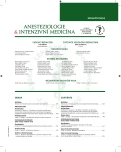-
Medical journals
- Career
Echocardiographic evaluation of the right ventricular function
Authors: Pořízka Michal
Authors‘ workplace: Klinika anesteziologie, resuscitace a intenzivní medicíny 1. LF, Univerzita Karlova v Praze a Všeobecná fakultní nemocnice v Praze
Published in: Anest. intenziv. Med., 25, 2014, č. 6, s. 427-433
Category: Postgraduate education - ECHO didactics
Overview
Right ventricular dysfunction often associated with pulmonary hypertension is one of the important risk factors of increased morbidity and mortality in critically ill patients. Many acute and chronic diseases represent possible provoking insults. Acute pulmonary hypertension associated with acute respiratory distress syndrome, pulmonary embolism, hyperhydration or structural heart disease in sepsis or myocardial infarction are the most common causes in the critically ill. Echocardiography as a part of extended ultrasound examination in intensive care enables evaluation of the systolic and diastolic function of the right ventricle, detection of valvulopathies, estimation of pulmonary hypertension or prediction of fluid responsiveness in a non-invasive and repeatable manner. Its routine implementation into daily practice provides complex haemodynamic monitoring and may ease the decision-making in the management of mechanical ventilation or fluid therapy in intensive care.
Keywords:
right ventricle – echocardiography – systolic dysfunction – pulmonary hypertension – fluid management
Sources
1. Chockalingam, A. et al. Acute left ventricular dysfunction in the critically ill. Chest, 2010, 138, 1, p. 198–207.
2. Haddad, F. et al. Right ventricular function in cardiovascular disease, part II: pathophysiology, clinical importance, and management of right ventricular silure. Circulation, 2008, 117, 13, p. 1717–1731.
3. Price, L. C. et al. Pulmonary vascular and right ventricular dysfunction in adult critical care: current and emerging options for management: a systematic literature review. Intensive Care Med., 2009, 35, p. 69–76.
4. Osman, D. et al. Incidence and prognostic value of right ventrcular failure in acute respiratory distress syndrome. Intensive Care Med., 2009, 35, p. 69–76.
5. Jacobs, A. K. et al. Cardiogenic shock caused by right ventricular infarction: a report from the SHOCK registry. J. Am. Coll. Cardiol., 2003, 41, p. 1273–1279.
6. Greyson, R. C. Pathophysiology of right ventricular failure. Crit. Care Med., 2008, 36, p. S57–S65.
7. Dell’Italia, L. J. The right ventricle: anatomy, physiology, and clinical importance. Curr. Probl. Cardiol., 1991, 16, p. 653–720.
8. Rudski, L.G. et al. Guidelines for the echocardiographic asses-sment of the right heart in adults: a report from the American Society of Echocardiography endorsed by the European Association of Echocardiography, a registered branch of the European Society of Cardiology, and the Canadian Society of Echocardiography. Am. Soc. Echocardiogr., 2010, 23, 7, p. 685–713.
9. Jardin, F. et al. Echocardiographic pattern of acute cor pulmonale. Chest, 1997, 111, p. 209–217.
10. Feissel, M. et al. The respiratory variation in inferior vena cava diameter as a guide to fluid therapy. Intensive Care Med., 2004, 30, 9, p. 1834–1837.
11. Vieillard-Baron, A. et al. Acute cor pulmonale in acute respiratory distress syndrome submitted to protective ventilation: Incidence, clinical implications, and prognosis. Crit. Care Med., 2001, 29, p. 1551–1555.
12. Nielsen, J. et al. Lung recruitment maneuver depresses central hemodynamics in patients following cardiac surgery. Intensive Care Med., 2005, 31, 9, p. 1189–1194.
Labels
Anaesthesiology, Resuscitation and Inten Intensive Care Medicine
Article was published inAnaesthesiology and Intensive Care Medicine

2014 Issue 6-
All articles in this issue
- Echocardiographic evaluation of the right ventricular function
-
Praktická doporučení pro vyšetření kardiovaskulárních funkcí a perioperační péči u pacientů podstupujících nesrdeční operaci
(American College of Cardiology/American Heart Association 2014) - Perioperative myocardial ischaemia and myocardial infarction
- The effect of clonidine on desfluraneconsumption using bispectral index monitoring during general anaesthesia: Randomised, double--blind, placebo controlled study
- Anaesthesiology and Intensive Care Medicine
- Journal archive
- Current issue
- Online only
- About the journal
Most read in this issue- Echocardiographic evaluation of the right ventricular function
- Perioperative myocardial ischaemia and myocardial infarction
-
Praktická doporučení pro vyšetření kardiovaskulárních funkcí a perioperační péči u pacientů podstupujících nesrdeční operaci
(American College of Cardiology/American Heart Association 2014) - The effect of clonidine on desfluraneconsumption using bispectral index monitoring during general anaesthesia: Randomised, double--blind, placebo controlled study
Login#ADS_BOTTOM_SCRIPTS#Forgotten passwordEnter the email address that you registered with. We will send you instructions on how to set a new password.
- Career

